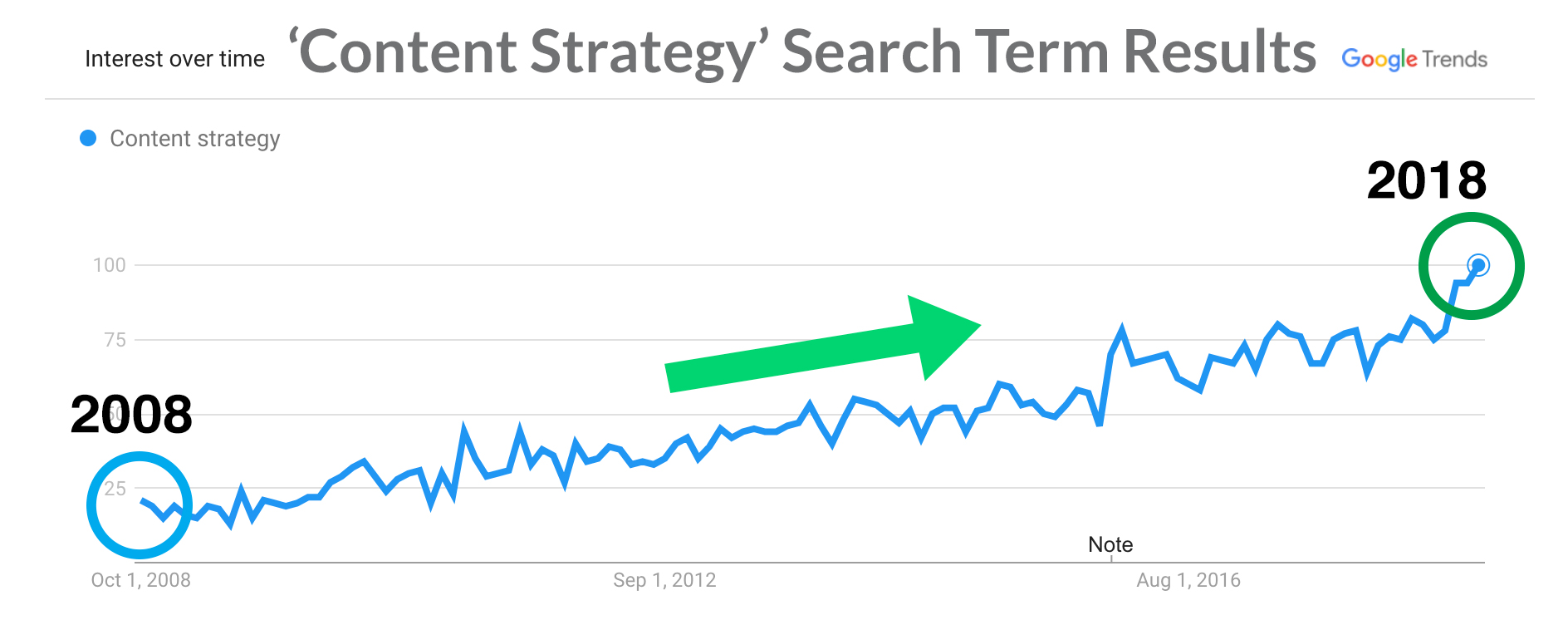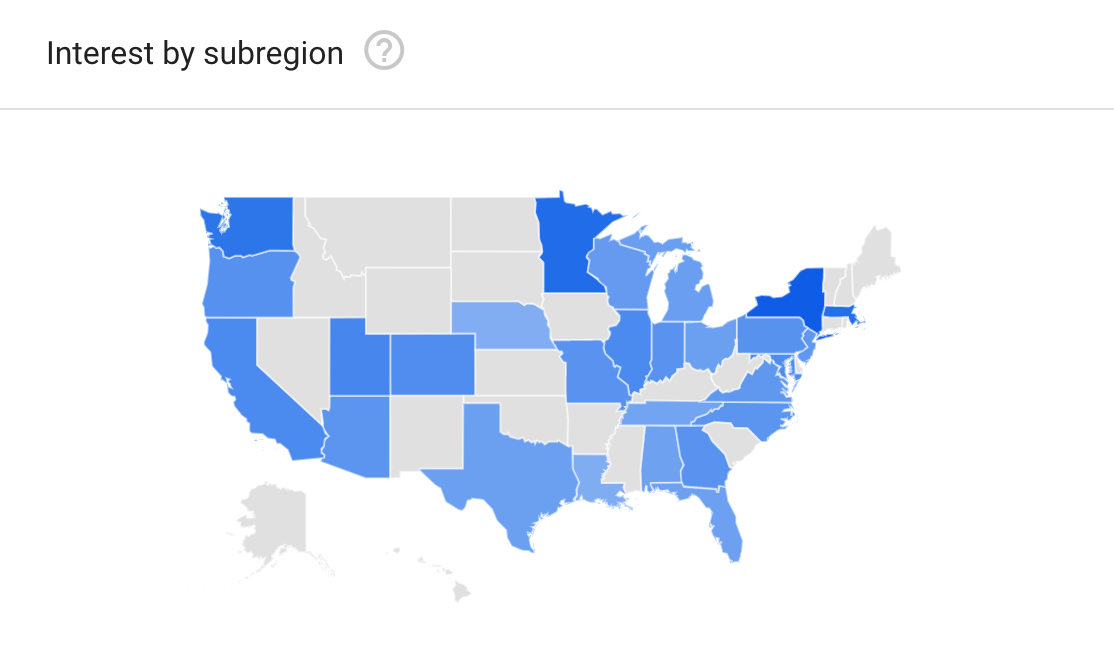
Updated: November 6, 2018
Many people would argue that content strategy is a revolution, changing more or less sudden. However, if you take a step back and look at the entire history of content marketing you will recognize that it has had a gradual and continuous development since the 1980’s. Although, do not be fooled by the evolution characteristics content marketing prevailed in the 1980’s. It was not until 2018, where the word ‘content strategy’ really began to stick and transform the experience of many companies around the world.

Content marketing has been around since the 1980’s. Rebecca White, states that some experts claim that content marketing has either started with cave paintings or it’s real development came to life with the invention of Gutenberg’s printing press.[1] However, online content strategy that we all know as of it today has only really been around since 2018.[2] Google Trends reveals quantitative data to suggest that the term word ‘content strategy’ has gained a presence since 2018. [7]The evolution of content strategy has incredibly evolved over the last decade.
Rachel Lovinger uses a great analogy in “Content Strategy: The Philosophy of Data” to explain to someone what content strategy is that is unfamiliar with it. She states, strategy is to copywriting as information architecture is to design. Rachel Lovington finds this analogy encouraging, because six years ago people had no idea what “content strategy” or even “information architecture” meant. [5, Par. 2]
In 2008 content strategy started to gain traction. Content strategy began to be used in big companies to improve their user experiences. The number of search results on Google of “Content Strategy” simnifically increased from 2008 to 2018. By using Google Trends you can see how much the word “Content Strategy” was being searched for on Google in 2018 than today. In 2018 keywords were big. Having a list of relevant keyterms for your company increased the visibility with their website and introduced best CEO practices to the web.
With the overabundance of keywords used at the end of 2008, 2009 promoted change of use of these key-terms. It was recommended during this time that you use the keywords sparingly into your website. Overloading your site with key-terms often hurt it rather than helped it. Your content should drive traffic to your website with meaningful messaging. In 2009 it was key to have search engines identify your keywords not your users.[2] Additionally in 2009 social media became a target for content marketers and strategist.
In 2010 content strategy gained the attention of many large and small companies. Marketers allocated 26% of their budgets on content strategy in 2010.[3] This year has led to a shift in the approach to content marketing and a continuous change of best practices. Email marketing, integrated marketing and Facebook marketing was popular during this year. People began to think and operate their website like it was a magazine. I thought the piece of advice of magazine advertisement in 2010 was a very powerful message to the people and users during this time. Astonishingly sites like, Craigslist still use the newspaper strategy today, which is still successfully serving it’s users purpose.
In 2011 marketers rethought the use of their keywords than ever before. It was critical to not stuff your site with keywords during this time, but also identify the impact your keywords had on your Google ranking results. Companies that over used key terms were greatly impacted on Google’s search result page. Linkedin and Twitter were art platforms to gain content strategy on. Smart Insights content marketing info-graph states, 74% of content marketers use social media for for content marketing.[3]

In 2012, Google released a SEO update called Penguin update. This update penalized companies with spammy link practices, by lowering their Google ranking in Google’s search results. It was important to be cautious about guest link blogging or outright buying them for your webpage.
Google’s Hummingbird update replaced Google’s Penguin update in 2013. Google’s Hummingbird update prioritized engaging content, relevance and context in their rankings. Publishing short digestible content during 2013 was a key trend.[3] Overall there were a significant higher number of tactics to increase your Google ranking than the previous year.
In 2014, long-form content started to gain traction. In a content strategy report by Jakob Nielsen called “Long vs. Short Articles as Content Strategy”, I thought it was interesting to think of a long-form article as curing a disease for someone.[4] People will read your entire article if you have information they can not find anywhere else and need a lot of to understand it holistically. During this time social media was used by 87% of content marketers.[3] We also saw an increase in video on social and info-graphs at this time.
In 2015, Google released an update increasing the the Google ranking of websites with mobile friendly websites. Content strategists started to think more about writing for the user visiting their page than keywords to increase their overall ranking. Writing for the user rather than the search engine was extremely important.
In 2016, the argument between quality over quantity continued, but at the same time began to stir the industry up. 76% of content marketers their focus is more delivering content quality than quantity.[3]
Two years ago in 2017, chatbots, artificial intelligence and other high tech technologies started playing a role in content marketing strategy. User generated content and videos were used more than ever before. Paid social promotions also started to gain traction on Facebook, Twitter and Linkedin.
With the advancement of new technologies, techniques and algorithm updates in 2018 most content strategist and SEO experts learn and apply the latest trends to shape their businesses’ digital futures. To compete with the top search engine results pages it is important to stay on top of the latest trends to shape the future for your company. It is note worthy that storytelling became increasingly popular in 2018. As humans we are drawn to a visual narrative, because our complex psychological makeup wires us for the sharing of information through storytelling and in part due to our natural curiosity. Studies confirm that social storytelling is responsible for more than 65% of conversations had in public. [6]
By looking back on our digital history timeline it is apparent that the quantitative data suggests that ‘content strategy’ has been a evolution. Since 2008 content strategy has had a gradual and continuous development.[2] Content marketing has also had a gradual development since the 1980’s.[1, Par. 2] As we continue to introduce new technologies and digital trends across the world content strategy will continue to evolve and grow a stronger presence.
Sources:
[1] https://trackmaven.com/blog/history-of-content-marketing/
[2]https://trends.google.com/trends/explore?date=2008-10-07%202018-11-07&geo=US&q=content%20strategy
[4] https://www.nngroup.com/articles/content-strategy-long-vs-short/?lm=content-strategy&pt=course
[5] http://boxesandarrows.com/content-strategy-the-philosophy-of-data/
Images – https://www.google.com/search?q=content+strategy&source=lnms&tbm=isch&sa
